MARIANI’S
August 31, 2008
NEWSLETTER
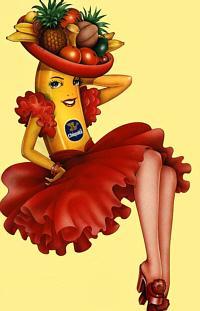
Chiquita Banana Ad, circa 1950
NEW! Click esquire.com
to go to my new column at Esquire Magazine.
ARCHIVE: Readers may now access
an
Archive of all past newsletters--each annotated--dating back to July,
2003, by simply clicking on www.johnmariani.com/archive
SUBSCRIBE AND
UN-SUBSCRIBE: You may subscribe anyone you wish
to this newsletter--free of charge--by
clicking here.
In
This Issue
NEW YORK CORNER: 81 by John Mariani
NOTES FROM THE WINE CELLAR: Chilean White Wines Seek to Share Reds’ Rep by John Mariani
QUICK BYTES
~~~~~~~~~~~~~
Yachting
the Inner Passage of Alaska
By Suzanne Wright
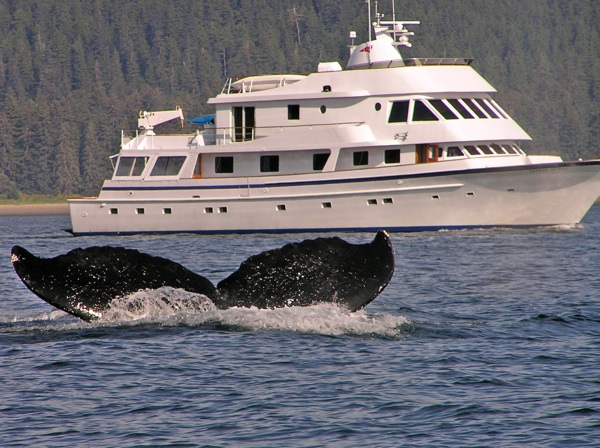
It’s
the ultimate dinner and a show.
That’s what I’m thinking as I am interrupted
mid-forkful of beef by a shout of “tail” from a steward. We’ve
heard it for days, but we respond with enthusiasm.
Simultaneously, each of the 31 guests onboard the Safari Explorer push
back our chairs, grab our binoculars and head up to the bow.
Beth, our exhibition leader, has spotted a pod of humpback whales
engaged in “bubble net feeding.” The whales dive deep under a
school of herring, form a circle and simultaneously blow their breath
out, creating a “net.” Their haunting calls frighten the
herring. The herding forces the herring to the surface, where the
humpbacks surge to the surface, their huge, gaping mouths capturing
their prey. Beth says this is a rare occurrence; that you could
come to Alaska for years and never see this sight. We are lucky.
“Whales rock,” she says. So do sea lions, bald eagles,
brown bear, Dall’s porpoises, Sitka black-tailed deer, seals, otters
and puffins, all of which we see during our seven-night American Safari
cruise in Alaska’s Inner Passage.
The journey begins and ends in Juneau, an unassuming
former gold mining, city of just 30,000 people, but it has a cool
vibe. A town, it has one great shoe store, several galleries and
lots of saloons. You can tour the charming Alaska State Museum
with tribal artifacts and the capitol, a former territorial building.
Fortuitously, my visit coincides with the annual Celebration.
More than 2,000 dancers from Tlinglit and Chilkat tribes in Alaska,
Canada and. Washington perform at several indoor and outdoor venues
wearing spectacular ermine-trimmed and button-festooned robes, beaded
dresses and clan hats.
Before boarding the yacht, we take a bus to Mendenhall
Glacier, one of 38 glaciers that flow from the Juneau Icefield.
The area is part of the Tongass National Forest (below), the largest in North
America, with old-growth Sitka spruce and western hemlocks. Peering
through a telescope in the Visitor Center, I can see mountain goats
scrambling up the mountains adjacent to the glacier; beavers are in
evidence at the creek. Mendenhall Lake has a milky color because
of the ground up rock, called glacier silt, it contains.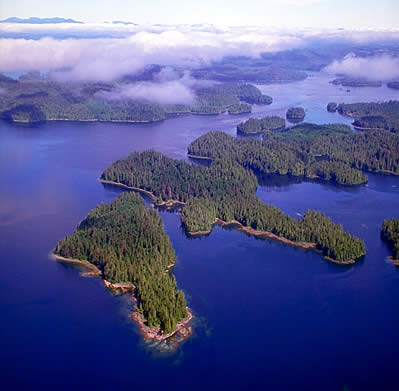
The excitement is palpable as we greet
the awaiting crew of the 145-foot Safari
Explorer, which holds just
36. According to the U.S. Fish and Wildlife service, wildlife
viewing is up in popularity in by 22% over the past five years. Because
of its size, we can ply waters larger vessels cannot. The advantages
are myriad: we can get up close and personal with wildlife, we
can reach little-seen villages, there are no waits for shore
excursions, we are flexible as we chart our course and we have less
impact on the environment.
My stateroom is casually elegant with a bathroom
with heated floors, an iPod docking station, and a flat screen TV.
There are no room keys. The guest/crew ratio is 2:1. The
combination living room, library, bar and dining area boasts a large
screen TV (for slide shows and lectures), leather couches and chairs,
board games, DVDs and books. Almost immediately, guests kick off
their shoes, some snuggling under throws, and chat, read or nap.
Camaraderie is a big part of the shared
small-ship experience. Many of us will exchange email addresses.
We are from different parts of the globe, we have different
occupations, we have different life experiences and we are of different
ages, yet we intermingle with ease.
Gourmet cuisine is another big part of the voyage, and
Chef Phil and his staff of two turn out regionally inspired, two-course
breakfasts and lunches and three-course dinners. We also enjoy
fresh-baked cookies every afternoon and pre-dinner hors d’ouevres
like salmon sashimi, potstickers or house-smoked cheddar.
Ninety-five percent of the food is prepared from scratch.
Breakfast might include a spinach and feta quiche
with Dungeness crab or apple oat pancakes with ham steak and red eye
gravy. My favorite lunch was our only buffet: a BBQ sampler with
pork ribs and grilled marbled King salmon, coleslaw with carrots,
cabbage and apples, home-style potato salad and mini pecan tarts.
Dinners featured tomato bisque, sockeye salmon with zucchini and summer
squash, Alaskan King crab legs, smoked black cod with pesto risotto,
rib eye with Stilton crumbles and cheesecake with raspberry puree.
Day 2
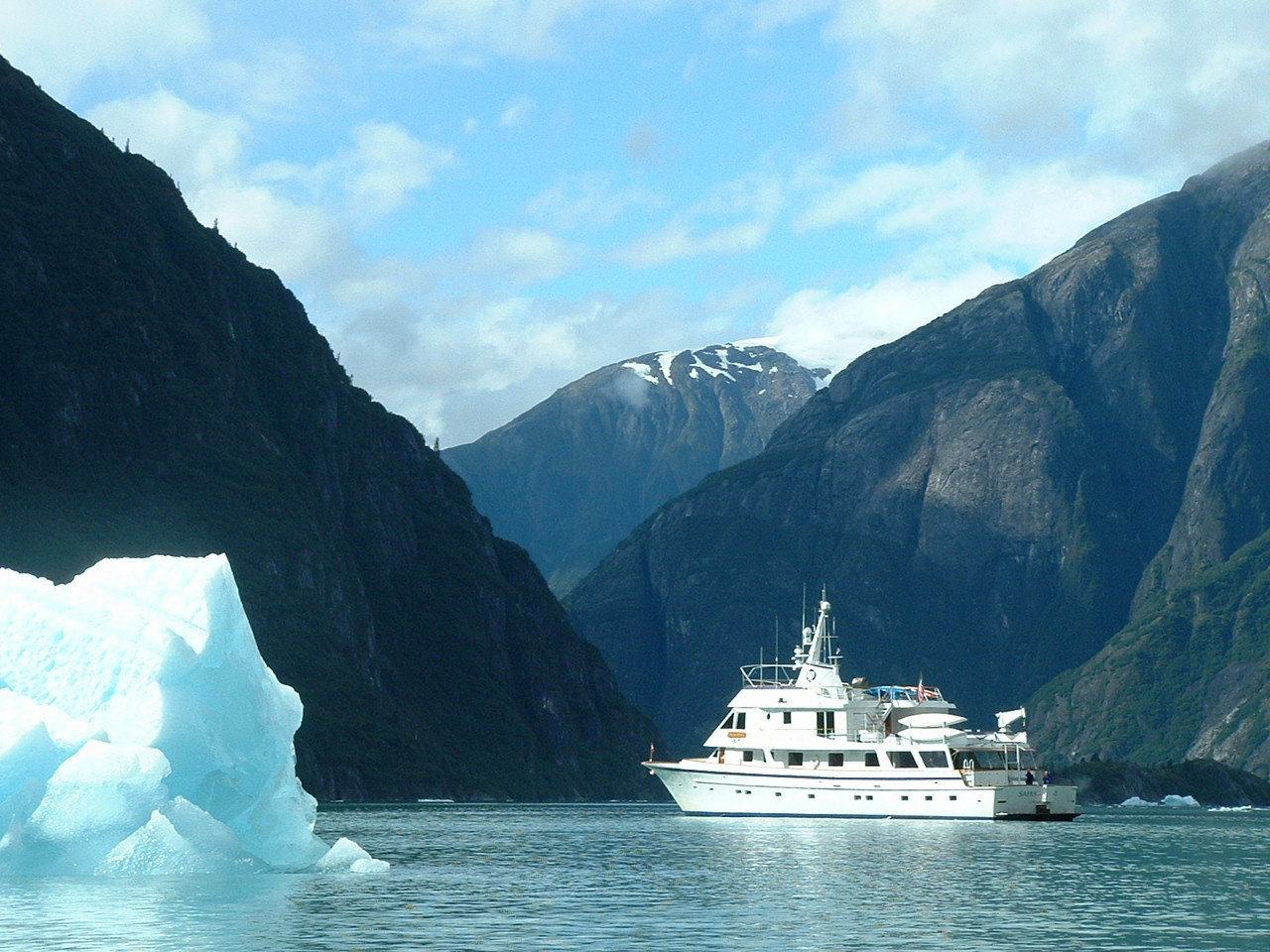 At
6 a.m., we stop to pick a U.S.
National
Service park ranger who will be pointing out wildlife and answering
questions while we are in Glacier Bay. The water is glassy, calm,
a Caribbean aqua. The park, a UNESCO Biosphere Reserve and World
Heritage site, is ever-changing, the result glacial movement. It
feels as though we have it to ourselves—there’s not another boat in
sight.
At
6 a.m., we stop to pick a U.S.
National
Service park ranger who will be pointing out wildlife and answering
questions while we are in Glacier Bay. The water is glassy, calm,
a Caribbean aqua. The park, a UNESCO Biosphere Reserve and World
Heritage site, is ever-changing, the result glacial movement. It
feels as though we have it to ourselves—there’s not another boat in
sight.
Alaska is two and half times the size of Texas, with
more designated wilderness area than any other state. Much of the
land is remote, with few roads; there are more licensed pilots in the
state than all other states combined. From the ship, the
unsullied and breathtaking grandeur of the place reveals itself.
The weather plays hide and seek as we traverse the fjord (left) where the
water plunges to 600 feet. Then it clears. The water
sparkles; the sun warms enough to remove a layer of clothing.
It’s a pristine early summer day, ideal for wildlife-watching.
First, we spot magnificent bald eagles diving for fish and
resting on icebergs. Then come the humpback whales, the largest
mammals in the world (some females are 50 feet or longer),
distinguished by their enormous fluke (tail fin) breaking the
surface. Next are the coastal brown bears, a mother and cub at
the shoreline. The female rears up on her hind legs as another
adult clambers down from the mountain. There are also cawing gulls and
puffins, perched on rock outcroppings, and harbor seals, slithering off
rocks into the water. It’s a lifetime’s worth of animal spotting, all
before lunch.
There are glaciers in Southeast Alaska the size of
Rhode Island. At Grand Pacific and Margerie Glaciers, we hope to
see dramatic “calving” as large chunks break off and crash into the
water. Just 200 years ago, this entire region was completely
covered by ice. Glacial ice is a special clear, brilliant shade
called storis blue. The ice appears blue because it absorbs all
colors of the visible light spectrum except blue, which it
transmits. As we drop anchor, we watch and listen to the stresses
and strains of melting ice, water dripping, air bubbles popping and
cracking. “Ice crispies,” Beth calls it.
We hear the calving before we see it: it
sounds like a giant thunder clap. Eyes riveted to the glacier in
front of us, we wait. A few minutes later, a huge block breaks
off and hurtles into the water—just like on TV. I have goose
bumps and not because I’m cold.
Later, we hike with Richard, our other onboard
naturalist, who points out the old man’s beard that hangs on the
hemlocks in the forest. It looks like Spanish moss and is an
indicator of good air quality and a lack of pollution. When I return to
my cabin, the bed’s been turned down with chocolates. Sweet
dreams indeed.
Day
3
Merlinda,
wellness instructor, has been offering yoga and
stretching every morning at 7 a.m. But I’m not an early
riser. Instead, I sign up for my complementary 45-minute massage.
There’s also a sauna and two step machines on deck. Just a few
steps away is the bridge. Open to guests 24/7, it could probably
accommodate all 31 of us at the same time. Scott is passing the
wheel after this trip and Shawnda will pilot the ship for the balance
of the season.
We’ve entered the richest whale waters in
Southeast Alaska. We don orange life vests, put our cameras in
the waterproof bags provided and climb into an inflatable skiff to get
nearer to these gentle giants. Humpbacks are endangered, but this
is their summer playground. It is thrilling when Beth spots
telltale plume spray: there’s a pod of five, including a mother and
calf. She cuts the engine and we watch, riveted, as a light rain
begins to fall. The humpbacks are aerobic, acrobatic whales,
diving, breaching and slapping their massive flukes on the surface of
the water. At one point they come within 15 feet of the skiff, their
huge knobby heads just above the water. We can feel the sea
spray. Then comes the money shot, when the Y-shaped fluke crests the
water. After 20 photographs, I finally snap proof. Sea
lions cavort just in front of the skiff. We might be a little wet
and a bit chilly, but we are energized.
Tonight, we celebrate the birthday of an 85-year old
female passenger with a candle-lit cake. She’s given a tiara to
wear, but I suspect she’d rather have a kayak paddle.
Day
4

Thousands
of sea lions on Brother’s Island jostle for
space on the rocks, bellowing their discontentment when a patch of
sunny stone is compromised. Talk about high-density living.
This morning’s excursion is kayaking in Kelp Bay where Sea
lions bob their heads up, playing a game of hide and seek. They follow
us, ducking below the surface as we attempt to steal a glance or take a
picture. When we round the rocks too close to them, they waddle
and slip with a splash into the water.
In the afternoon, we pull into Baranoff Harbor
to hike to the hot springs. The sulfuric smell fills the air as
we disrobe to our bathing suits. The springs are located in a
shallow rock pool directly over rushing falls; the rocks are slimy with
moss but the water feels silky and warm. One of the group
brandishes a bottle of champagne from his backpack and pours each of
the (all-female) “Baranoff Babes” a plastic cup of bubbly.
We hike further into the woods, coming upon
skunk cabbage. It’s well named—the odoriferous plant fills our
nostrils before we see the bright yellow flowers and waxy leaves.
Richard tells us Indians used to wrap fish in them. The ground
underfoot is mossy, springy and spongy; the forest looks almost
fairylike. One passenger spontaneously hugs a giant tree.
Day 5
We’ve
pulled into
Petersburg, a Norwegian
fishing village (below).
It’s the quintessential Alaska fishing
town—think Northern Exposure. The hardware store sells
groceries. There’s also a great bookstore where several of us
replenish our reading material. The townspeople are friendly and
stop their trucks to let us (jay)walk across the street.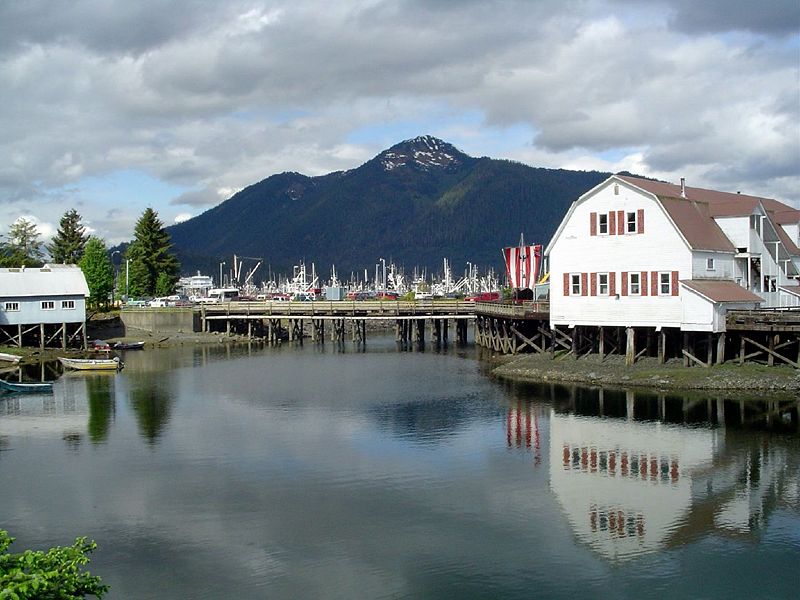
A small group of us bike around town. We spy
two Sitka-black tail deer on the front lawn of a house. They are
not spooked by us at all. The owner is backing out of his
driveway. He rolls down his window when he sees we have stopped
to admire them. “They’re a nuisance,” he shouts with a
smile. “You can have ‘em. I can’t keep them out of my yard.”
After dinner, we get another show as Dall’s porpoises appear below the bow. With their unique black and white coloration and thick-in-the-middle bodies they look like miniatures Orcas. We lean over the rail to get a closer look; at one point I count ten of them. I try to react quickly enough to catch them on camera, but their rapid-fire swimming, jumping and zipping from side to side shows up as a splash and bubbles on all my shots. Photo by Mike Colvin
Day
6
It’s raining this morning, so we don rubber boots and raingear (provided by the Explorer) for the skiff excursion to look for brown bears at Admiralty Island; sadly, it’s a bust. Many of us opt for a dip in the hot tub. I opt for a nap and a DVD. Call it a mini hibernation.
We
are hugging the
steep fjord walls of
Endicott Arm and Ford’s Terror. The name comes from a naval crew
member who rowed a dinghy into the narrow entrance at slack tide in
1889. As the tide began to rise, Ford was trapped in the
turbulent current of the granite-chiseled canyon for six terrifying
hours.
We’ve dropped anchor. The weather,
mostly warm and sunny all week, has turned rainy, chilly and a bit
melancholic but it’s hardly terrifying. Still, Beth, our onboard
exhibition leader, gives us a serious safety briefing before we launch
our kayaks. “Watch out for icebergs—and not just the big
ones. Even the bitty bergs can capsize your kayak. You
can’t see what’s underneath.” Dawes Glacier is both spectacular and
surreal; I feel as if I am floating in a giant cocktail.
Some chunks of ice are the size of cars;
others the size of ice cubes. The water is gin-clear, aquamarine,
smooth as glass. It’s quiet, so quiet that the only sounds I hear are
the paddle slapping water, a seal crying out and ice creaking, cracking
and shifting. I begin clicking off pictures, trying to capture
this moment.
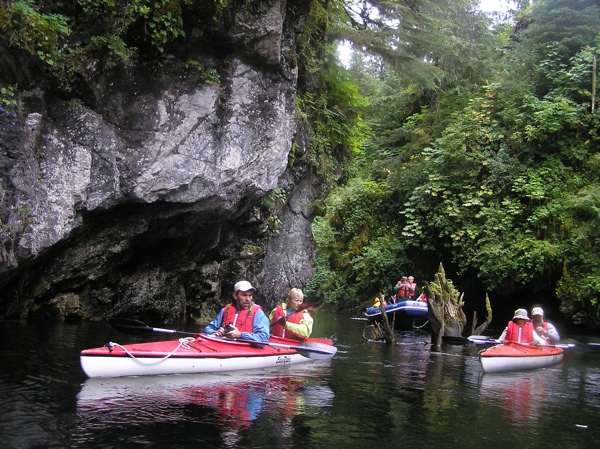 We begin to paddle, heading toward the wall of ice
that glistens a couple of miles ahead of us. It takes us a few
moments to gain a rhythm, to get our paddling in sync, and we have to
make split-second decisions about the potential hazard of the
icebergs—big and small—in our path. I shout out the simplest,
most succinct directions: “Iceberg right, steer left.” “Big
iceberg ahead. Bear right, then straight.”
We begin to paddle, heading toward the wall of ice
that glistens a couple of miles ahead of us. It takes us a few
moments to gain a rhythm, to get our paddling in sync, and we have to
make split-second decisions about the potential hazard of the
icebergs—big and small—in our path. I shout out the simplest,
most succinct directions: “Iceberg right, steer left.” “Big
iceberg ahead. Bear right, then straight.”
We paddle toward a huge iceberg that glints like
blue topaz. A harbor seal pop its head above the surface. We
paddle toward a mother and pup on an ice floe, getting within a paddle
length before they slip into the water. We paddle toward the rocky
shoreline, then back toward the glacier. We take turns coasting,
putting the paddles across our laps and taking photographs. Or
just listening intently for the tell-tale boom of calving.
Slowly, almost imperceptibly, the sun comes out.
Misty clouds lift from the mountains. The icebergs begin to melt like a
huge slushy. There are fewer, less imposing obstructions and we
navigate with greater ease. Fewer words are exchanged. We
have gained some mastery and more than a little faith in our abilities
in the past hour.
All too soon, Beth is signaling for us to return to the
ship. Bradley and I are the last of the passengers to paddle in;
we jokingly contemplate making a break for it, forcing the boat to
chase us through the fjord, thinking we are nimble enough to elude the
captain.
Back onboard, Elaine, the bartender, uses an ice pick to
break up a CPU-sized block of glacier ice and proposes a martini.
“It’s the purest ice you’ll ever have,” she says with a grin. “Cheers.”
We clink glasses.
At the farewell dinner, champagne is poured and Captain Scott speaks of friendships that are formed during oceanic voyages. Beth shows a photographic slideshow of the weeks’ activities to raucous good cheer (we will receive a copy during breakfast before we disembark the next morning). Even though we have to be in port at Juneau early the next morning, no one wants to end the night, so Elaine obliges us into the wee hours.
The
Safari
Explorer’s season in Alaska runs from May to September. For information
and reservations, log onto www.amsafari.com.
Suzanne Wright is a writer living in
Atlanta and founder of www.writesquared.com.
~~~~~~~~~~~~~~~~~~~~~~~~~~~~~~~~~~~~~~~~
NEW
YORK CORNER
by John Mariani
eighty one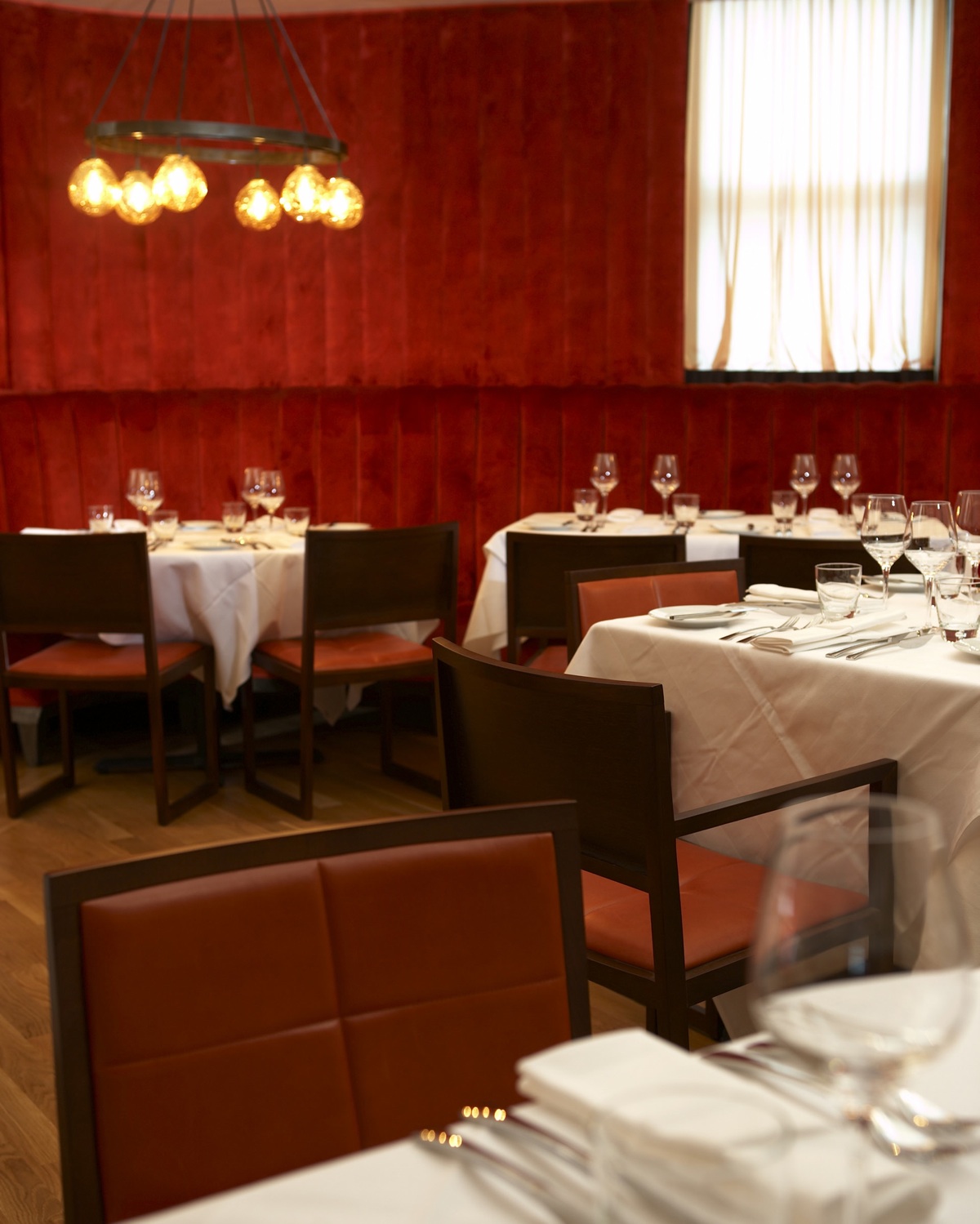
45 W 81st Street (near Central Park West)
212-873-8181
www.81nyc.com
for
many, many years my family's Christmas outing was to go to Rockefeller
Center to have lunch at the Sea Grill, skate on the ice rink, and take
in the great lighted fir tree. But while the skating and the tree
still hold their wonder, I haven't been back to the Sea Grill
since chef Edward Brown, who had been there 17 years, left
a year or so years ago. Fortunately he has reappeared, now
on his own, at Eighty One, a splendid new Upper West Side restaurant
near the Museum of Natural History.
Brown's impressive résumé,
before the Sea
Grill, includes stints at the Maurice under Alain Senderens and
Christian DeLouvrier, and before that at Lucas Carton in Paris.
His own book, The Modern Seafood Cook (1995),
is
still one of the best on the subject. So I was all prepared to
see what
Brown could do with non-piscine fare too.
Eighty One is a deep, broad restaurant with
high-backed booths, deep red lipstick colors, and polished wood floors.
The
tables are well set with the finest napery, stemware, and silverware,
the winelist
is very strong on every count, and service is amiable throughout the
evening, well attiuned to the pacing of the kitchen. Over
two visits the decibel level in the full room never rose
above the conversational level. This is a fine restaurant for people
who want to dine, not be part of a scene.
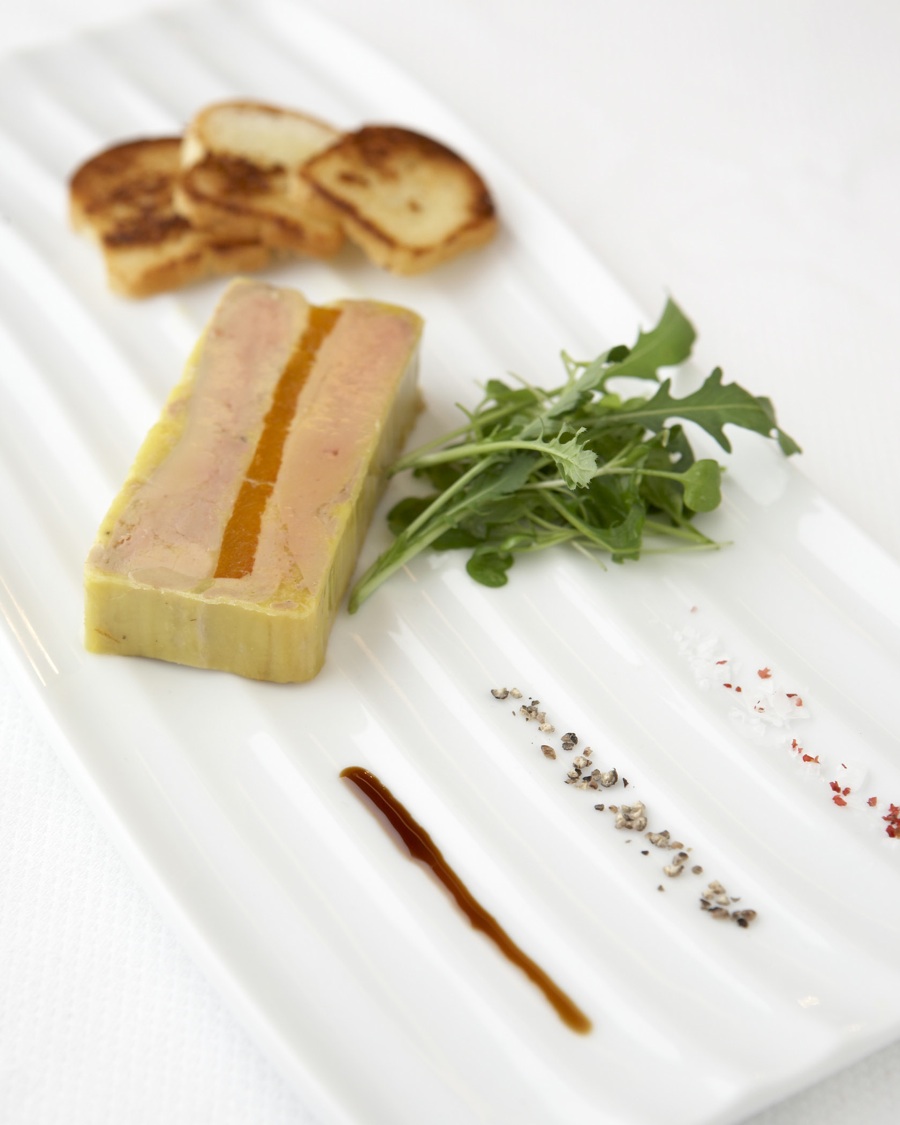 Brown's
modern American cuisine shows the deft way he used to focus on fish
species to bring out their best, now with meat, fowl, and
vegetables. He combines foie gras and chicken in a terrine (left), light and mild, with baby
arugula, celeriac, apples, and truffles. Wonderful New Bedford
sea scallops and foie gras ravioli in a chervil-based wine sauce makes
for a refined starter. One evening gnocchi
parisienne were much too soft and starchy, but a summer's fava
bean and pea soup with fromage blanc,
a hint of garlic, and crab
croquette showed marvelous delicacy and flavor. Crispy softshell crabs
were fat, sweet, and indeed crispy.
Brown's
modern American cuisine shows the deft way he used to focus on fish
species to bring out their best, now with meat, fowl, and
vegetables. He combines foie gras and chicken in a terrine (left), light and mild, with baby
arugula, celeriac, apples, and truffles. Wonderful New Bedford
sea scallops and foie gras ravioli in a chervil-based wine sauce makes
for a refined starter. One evening gnocchi
parisienne were much too soft and starchy, but a summer's fava
bean and pea soup with fromage blanc,
a hint of garlic, and crab
croquette showed marvelous delicacy and flavor. Crispy softshell crabs
were fat, sweet, and indeed crispy.
he
cooks fluke on the Spanish griddle, giving it a gentle sear, then
combines it with summer's vegetables in a fresh lemon-thyme broth. His
succulent roast squab comes with peppery purslane, walnuts for texture,
and caramelized daikon for sweetness. And Colorado lamb comes two ways,
with roasted baby zucchini and the lovely creamy touch of ricotta. You
can taste in every dish the finesse and respect he has for the
principal ingredients, because they are always top of the season.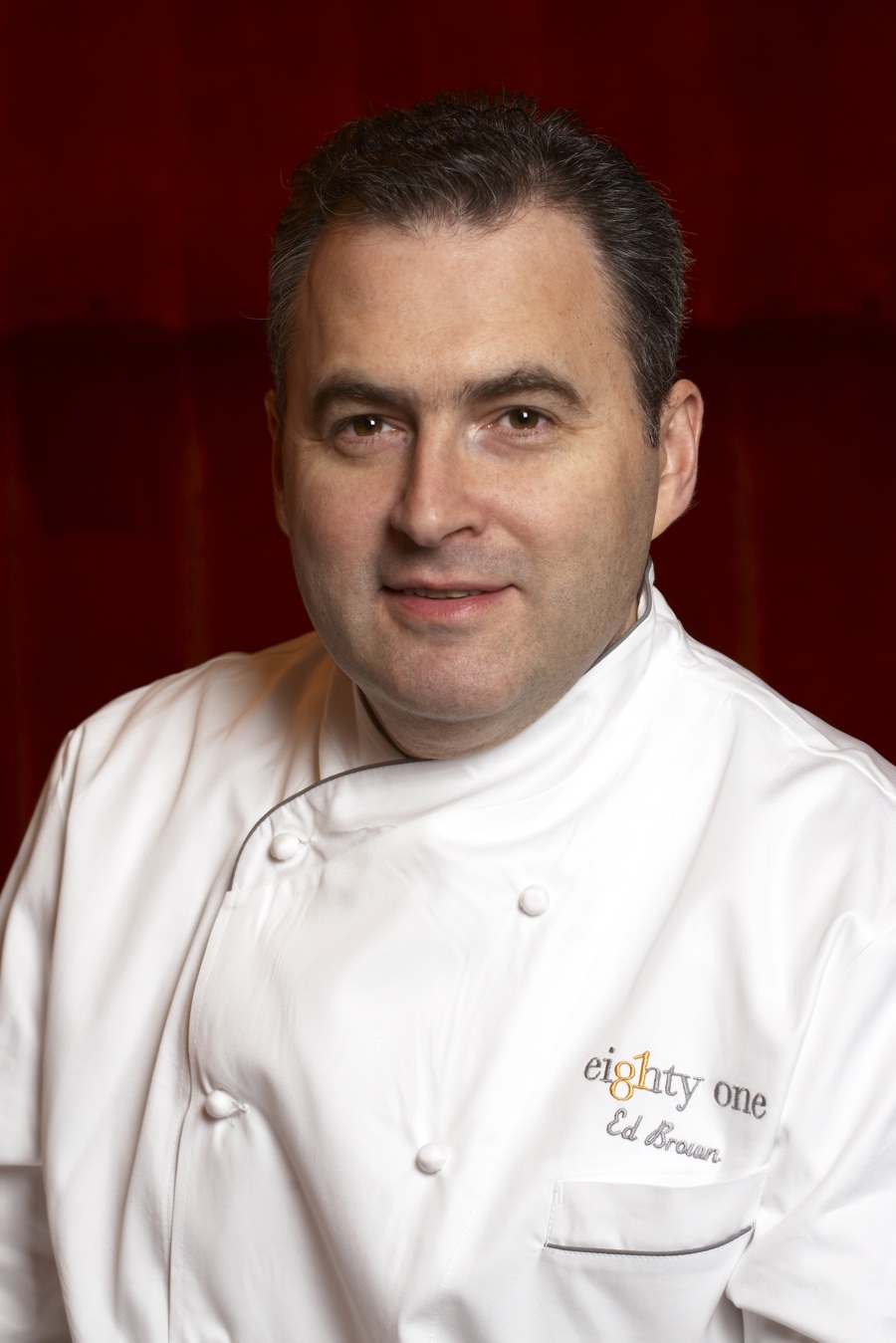
For dessert John Miele provides more
complex, textured dishes; his bittersweet chocolate-hazelnut
mille-feuille
with Mandarin hot fudge and a white chocolate crèmeux will give you the
general idea; there's also a fine Meyer lemon frozen soufflé
with lemongrass pannacotta, pistachio, and a blood orange sorbet.
Brown (right) has said he wants elegance
with comfort at 81, and that is what you get. It's not at all stuffy,
but the propriety of good service and sophisticated cooking makes this
(still) a rarity on the West Side, where restaurants get better all the
time--just not with this much refinement.
Appetizers run $14-$19, entrees $28-$39.
~~~~~~~~~~~~~~~~~~~~~~~~~~~~~~~~~~~~~~~
NOTES
FROM THE WINE CELLAR
Chilean White Wines Seek to Share
Reds' Rep
While
Chilean red wines like Concha y Toro’s Almaviva, Casa Lapostolle’s
Apalta, and Montes Alpha “M” have achieved real status among the wine
media and the enviable sales to go along with them, Chile’s white wines
have not, as yet, fared quite so luminously.
Of course, white wines have a lot of catching
up to do in Chile, where the Spanish brought red wine grapes, mainly
Pais, during the colonial period. Indeed, red European varietals like
cabernet sauvignon and carmenere were only really planted there as of
there 1980s, and, only in the last decade, has modern technology
allowed vintners to boost white wine quality.
 Overall, Chile’s wine industry is booming: in 2007, Chile
was the fourth in bottled wine market share, with 8% of the imported
bottled wine market in the US, according to the Gomberg-Fredrikson
Report. Imports of Chilean wine increased by 13% in 2007 and increased
in value by 24%, up to $207 million. Currently, Chile is the only one
of the top ten wine- producing countries in the world showing an
overall increase—2 percent--in wines being imported to the US. Of
that amount, white wines grew by 9 percent, making up 24 percent of the
Chilean wine brought into the US. The most recent data, from the of
2006, shows that there are 28,468 hectares of white wine planted in
Chile, which is a remarkable 24.4 percent of all vines planted.
Overall, Chile’s wine industry is booming: in 2007, Chile
was the fourth in bottled wine market share, with 8% of the imported
bottled wine market in the US, according to the Gomberg-Fredrikson
Report. Imports of Chilean wine increased by 13% in 2007 and increased
in value by 24%, up to $207 million. Currently, Chile is the only one
of the top ten wine- producing countries in the world showing an
overall increase—2 percent--in wines being imported to the US. Of
that amount, white wines grew by 9 percent, making up 24 percent of the
Chilean wine brought into the US. The most recent data, from the of
2006, shows that there are 28,468 hectares of white wine planted in
Chile, which is a remarkable 24.4 percent of all vines planted.
The two main white Chilean varietals are
sauvignon blanc (8,697 hectares) and chardonnay (8,548 hectares), with
viognier beginning to make some gains. Shamefully, it was not until the
1990s that Chilean vintners admitted that a lot of what they said was
sauvignon blanc was actually the unrelated, inferior sauvignonasse,
also called sauvignon vert. Those days are, apparently, long gone.
Chile’s vineyard regions spread up and
down the Pacific coast, whose winds cool the white grapevines in the
morning and evening, from Casablanca in the north to Bio-Bio in the
south. The soils seem to favor the kind of fruit ripeness these days
preferred in white wines, especially sauvignon blanc, which I found the
most desirable of the dozen examples of Chilean whites I tried.
I expected to find the wines refreshing
and bright—all from recent vintages—as an aperitif, but because some
reach a minimum of 13.5 percent alcohol, they go very well with food,
which included a salad of avocado, chickpeas, and peppers. To my
surprise, the chardonnays, with their mellow acids, went well with
lasagna made with mozzarella, ricotta, and parmesan cheeses with tomato
sauce, because the creaminess of the cheese is ideal with chardonnay,
and the sweetness of the tomato (itself a fruit, not a vegetable) was
enhanced by the wine.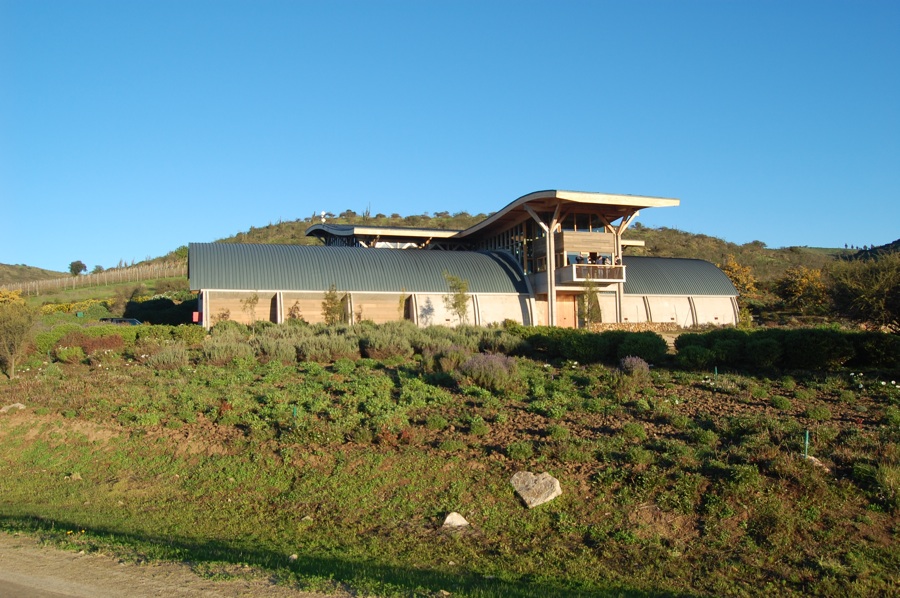
By far the largest wine producer in Chile,
with sales in excess of 6 million cases annually, Concha y Toro was
founded in 1883. (It now has a 50-50 agreement with France’s Baron
Philippe de Rothschild SA company to make Grand Cru class red wines
like those from Château Mouton-Rothschild.) Concha y Toro’s
Terrunyo Sauvignon Blanc Vineyard Selection (Block 28) 2006
($22-$25; above) was a
striking example of
how far Chilean whites have come. The seductive tropical fruit is
definitely there, but this is no fruit punch. Its balance of acid,
flinty notes, and creamy smoothness on the finish make it uniquely
Chilean, without the cloying sweetness of so many New Zealand sauvignon
blancs or the acrid grassiness of lesser Sancerres.
Punto
Niño Sauvignon Blanc 2007,
from the Casablanca Valley, is a great buy at $15, a brisk and
refreshing wine with which to enjoy tapas like shrimp, sardines, and
cheeses, with a pretty floral bouquet and just enough fruit, minerals,
and crisp acid to keep it on the dinner table.
Casa
Marin Sauvignon Blanc Laurel 2007 ($22) also has a fine,
passion flower nose, but it was far
too fruity
and a tad too sweet to enjoy with most foods aside from a nibble of
country bread with an olive tapenade.
Of
the chardonnays I tried, I was not
much taken with Los Vascos 2007
($9-$10) from Colchagua Valley.
This winery also has a Rothschild connection—this time Lafite—and they
make a pleasant Bordeaux-style red called Le Dix. But this
chardonnay had almost no color whatsoever, little of the aroma of a
white Burgundy, and none of the oak and caramel of a California
example. It was simply a bland, ten-dollar white wine.
The Garces Silver family’s Amayna Chardonnay 2005 ($20) is
a limited run of only 1.543 cases, and it shows the benefits of oak and
age without crossing the line into muscularity. At 14 percent
alcohol it’s a bold white wine, and I sensed that it is at its peak
right now and probably won’t gain further maturity. Drink it right now
with the last lobsters of summer.
~~~~~~~~~~From September 18-30 the trade organization Wines of Chile will partner with Gourmet Magazine to present the third annual "Salud! Chilean Wine Fest" in New York. Thirty restaurants and ten retail wine stores will be showcasing Chilean wines, some with complementary tastings. Restaurants include A Voce, Blue Fin, Porcao Churrascaria, The Modern, Spice Market, and others. For info go to www.winesofchile.org or write to info@winesofchileusa.com.~~~~~~~~~~~~~~~~~~~~~~~~~~~~~~~~~~~~~~~~~~~~~~~~~~~~~~
John Mariani's weekly wine column appears in Bloomberg Muse News, from which this story was adapted. Bloomberg News covers Culture from art, books, and theater to wine, travel, and food on a daily basis, and some of its articles play on the Saturday Bloomberg Radio and TV.
PRIDE,
PRIDE, PRIDE! THRUM, THRUM, THRUM!
“The road beckons, so we heed its call and peel out. The radio’s playing a song with a gravelly refrain that goes `Minnesota. . . we got pride, pride, pride!’ Motorcycle gangs, all bandannas and flapping leather fringe, thrum down the asphalt. A crust of butterflies forms on the front bumper. We slow down to let wild horses cross, and I wrestle splinters of beef jerky out of my molars.”--Nathalie Jordi, “Farm Fresh,” Condé Nast Traveler (August 2008).
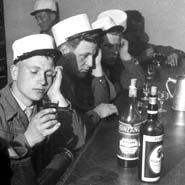
DRINK UP, MES AMIS, FOR TOMORROW YOU MAY BE BACK IN ALGERIA!
The
French Foreign Legion is producing a wine called
"Esprit de Corps" to raise funds for its veterans. The 2007 Côtes
de Provence red and rosé vintages are produced from grapes grown
in southern France where its war-wounded and former fighters work
in the vineyard. Lieutenant-Colonel Xavier Lantaires described them as
“strong when attacked, solid on the onslaught, full of grapeshot on the
front line."
QUICK
BYTES
* On Sept. 6 the Napa
Valley Grapegrowers will hold the Harvest STOMP at the Round
Pond Estate in Rutherford. Guests will enjoy local cuisine and have the
opportunity to meet Napa Valley's most notable grapegrowers pouring
wines, dancing to great bands, an instant cellar raffle, and a live
auction. $100 pp. Also, exclusive luncheons hosted by
pioneering grapegrowing families at vineyards not typically open to the
public, at $300 pp. Call 707-944-831.
* In Paris , guests of Hôtel Le Bristol’s Bar can
enjoy a trio
of mini-sandwiches for either lunch or dinner, a novel idea from Chef
Eric Frechon and by Bakery Chef Wesley Tulwa, as an entire meal
complete with a starter, main course and dessert. Accompanying
the
assortment is a sandwich in the form of a drink. 38 Euros.
Call +33
(0)1 53 43 43 42 or visit www.lebristolparis.com.
* Throughout September, Lark
Creek Restaurant Group will offer special dessert menus in each
of its Bay Area restaurants made with the best of American chocolate,
incl. E. Guittard and Scharffenberger. Participating restaurants
include The Lark Creek Inn (415.924.7766), One Market Restaurant
(415.777.5577), LarkCreekSteak (415.593.4100), Lark Creek Walnut Creek
(925.256.1234), Yankee Pier in Larkspur (415.924.7676), Yankee Pier in
Lafayette (925.283.4100), Yankee Pier at Santana Row in San Jose
(408.244.1244), Parcel 104 in Santa Clara (408.974.6104) and Bradley
Ogden at Caesars Palace in Las Vegas (702) 731-7413).
* From Sept. 6-12 the Denver
Independent Network of Restaurants (DINR) has created "Harvest
Week," a weeklong celebration of Colorado’s produce and
products, with the Colorado Wine Board, Colorado Proud, and the
Denver Metro Convention & Visitors Bureau. Restaurants may do a
4-course meal with Colorado wine pairings; a selection of local beers ;
or a wine tasting with local wines and cheeses. In addition,
several restaurants will host individual programs and events incl.
talks with local farmers; presentations by Denver Urban Gardens; pick
and cook events with kids; and much more. Fir a list of restaurants go
to www.eatdenver.com.
* This autumn the Taj
Boston Hotel “Brunch on The Roof " on the 17th floor features
Chef Franck Steigerwald’s buffet along with a special presentation of
Indian cuisine by Chef Prabeen Prathapan and desserts by Taj Boston
pastry chef, Susan Lagalle. Taj Boston Brunch on The Roof is on Sept.
7, 14, 28, Oct. 12, 19, 26 and Nov. 2, 9, and 16. $62 pp., $30
for children. The Taj Boston Brunch on The Roof Package rates start at
$499. Call 617-598-5255; visit www.tajhotels.com.
* On Sept. 8 An
Heirloom Tomato Dinner will take place at Cantinetta Luca in
Carmel, CA, with a tomato reception at 6:30 pm, followed by
dinner. $105 pp. Chefs incl. Jason Balestrieri, Cantinetta
Luca; Christophe Grosjean, Aubergine at L’Auberge Carmel; Jesse
Kloskey, Bouchée Bistro; and Ron Mendoza Mirabel Hotel &
Restaurant Group, with wine pairings by Thomas Perez, Wine Director,
Mirabel Hotel & Restaurant Group, Carmel. Call 831-626-7880.
* On Sept. 10 in NYC, Alto will hold a dinner with Lombardy's most acclaimed winemaker, Nino Negri's Casimiro Maule. $215 pp. Call 212-308-1099 or email Eric Zillier, Wine Director, at eric@zillier.com.
* September is California
Wine Month in NYC, with a month-long series of tasting events,
incl: Sept. 9--Santa Barbara and Napa Valley at Morrell Wine Store;
Tale of Two Valleys at Union Square Wines & Spirits; California
regional wines tasting Harlem Vintage Wine Shop & Bar; Sept.
10--California Wine Rush Consumer Tasting at Espace; 1Sept. 11--Napa
Valley Wine Dinner featuring Margaret Duckhorn at Zachys; Sept.
12--Santa Barbara, Sonoma & Carneros wine tastingat Zachys; Sept.
13--Paso Robles, Mendocino & Napa wine tasting at Zachys. Ticket
proceeds benefit the Central Park Conservancy. Visit
www.localwineevents.com/New-York-City-Wine/event-188135.html.
* On Sept. 12 the Third Annual "NY Brewfest" will be held at NYC’s South Street Seaport , with more than 100 Local, Regional, National, and International Craft Breweries to Participate Plus: Live Music and Barbecue from Spanky's . Held by The New York State Brewers Association and Heartland Brewery. $50 pp. Visit www.nybrewfest.com.
* On Sept. 13, Westport
Rivers, Buzzards Bay Brewing in Westport, MA, help Levin
Gillespie raise money to save “AN AFRICAN GARDEN”
A Women’s Cooperative
Garden Relocation Project:
A Peace Corps Initiative For Wompou,
Mauritania, Africa, by holding a party whose $25
ticket price incl/ a
cash bar ash Bar for beer, wine & soft drinks, local art vendors,
raffle & silent auction
Live music by
Rebecca Correia, Jack
Jennings & Royal. Call
508 264-4841.
* Chef Jean-Georges
Vongerichten now offers a "Culinary Master Course" at Trump
International Hotel & Towel New York incl. a 2-hour private
cooking lesson in the kitchen of his namesake restaurant, 3
nights in an Executive Park View Suites, 3-course dinner for two with a
bottle of Champagne, Breakfast for two daily at Nougatine, and signed
copy of Asian Flavors of Jean-Georges. $8,999. Visit www.trumpintl.com.
* On Sept. 13 in Brewster, MA, Chillingsworth will hold a Vintner's
with the Chateau St. Michelle portfolio of wines. $125 pp. . .
Oct. 18: The Annual Game Dinner; Nov. 15 : Beaujolais
Nouveau. Visit www.chillingsworth.com.
* On Sept. 13 the 25th anniversary of Masa’s Restaurant in San Francisco
will be toasted in benefit for St. Jude’s Children’s Research
Hospital. Chef Gregory Short has invited Masa’s alumni Julian
Serrano, Elizabeth Falkner, Richard Reddington and pastry chef Keith
Jeanminette, for a 9-course tasting menu. Two seating’s. $250 pp. Wine
pairing selected by Masa’s Master Sommelier Alan Murray
additional. Call 415-989-7154.
* On Sept 13, the 14th
Annual Staglin Family Vineyard Music Festival for Mental Health
will be held at the Staglin Family Vineyard in Rutherford, Napa Valley,
feauturing the music of The Pointer Sisters.
Chef Mark Dommen of
One Market Restaurant will cook for attendees at the VIP post-concert
dinner, and chef Todd Humphries of Martini House in St. Helena, Napa
Valley will provide pre-concert hors d’oeuvres with over 70 of the Napa
Valley and Sonoma County’s best wines. Visit
www.music-festival.org,
call (707) 944-0477, or email cindy@music-festival.org.
* On Sept. 14 in Boston, in honor of
the shellfishermen and women of the Bay State's coastal
waters, the Massachusetts
Aquaculture Association (MAA) is
uniting a shellfish farmers to celebrate its first
Shellfish Shindig at the Samuel Adams Brewery, with demos of shellfish
preparation. Samuel Adams brews will be paired with each
dish. Rowan Jacobsen, author of A Geography of
Oysters, will host a book signing and discussion. $10
pp. Call 508-934-9753.
* On Sept. 16 StarChefs.com celebrates the New York Rising Stars Chef Awards at the American Museum of Natural History with a walk-around tasting gala. $150 pp. Visit www.starchefs.com/risingstars or call 212-966-3775.
* On Sept. 16 Angelina’s
Ristorante in Tuckahoe, NY, will host a 5-course wine dinner
with Jordan Winery. $100 pp. Call 914-793-7319.
* On Sept. 16 three of Washington D.C.’s Irish-American
chefs will combine their expertise for an evening of cuisine and Irish
culture at Sewall-Belmont House--Brian
McBride of the Blue Duck Tavern, Tracy O’Grady of Willow Restaurant,
and Geoff Tracy of Chef Geoff’s and Lia’s Restaurant/ Pete Moss and the
Bog Band will provide entertainment. Call 202-772-3824; visit
www.wiprogram.org/donat
* On Sept. 18 in Oak Brook, Ill, Reel Club will present a
4-course “Dinner and Wine to Fall in Love With,” hosted by
chef Alpana Singh. $75 pp. Call 630-368-9400; visit
www.reel-club.com.
* On Sept. 18, Del
Posto in NYC will play
host to “Magic, Martinis & Mario,” with Mario Batali, mixologist
Tony Abou-Ganim and comedian Billy Harris for a 4-course Italian menu
with wines from La Mozza. Guests may also a variety of s prizes. A
percentage of the proceeds will benefit the EarthLab Foundation.
Call 630- 618-4756 or darcie@magicmartinismario.com . Tix are $1500.
* The Wine Academy of
Spain is hosting a traveling, in-depth, two-and-a-half-day
seminar series on the wines of Spain, beginning in NYC (Oct. 21-23),
then San Francisco (Oct. 27-29), and conclude in L.A. (Oct. 30-Nov.
1). Testing on the third day is optional, but those who pass will
receive the title of Spanish Wine Educator. The top 15 scorers will
have the opportunity to travel to Spain for further training in 2008,
incl. a week-long trip with meals, lodging, tours and seminars.
Those who pass the exam in Spain earn the title of Spanish Wine
Ambassador. Contact: info@thewineacademy.com; call +34 91 781 63
67 or visit www.spainwines.es.
* To celebrate Gidleigh
Park's (Chagford, Devon, England) 80th Anniversary year,
executive chef Michael Caines is welcoming a handful of talented chefs
this Autumn: Sept. 22: Atul Kochhar from Benares, in
London. Oct. 16: Shaun Hill (Merchant House in Ludlow and The
Walnut Tree - Abergavenny) ; Nov. 17: Adam Simmonds, of the Oak
Room, Danesfield House in Buckinghamshire. Visit www.gidleigh.com/news
* Asia Transpacific
Journeys of Boulder, CO, offers a new
tour, "The Cuisine and Culture of Thailand and Vietnam," a 14-day trip
small group trip departing Feb. 7. Package incl. incl. accommodations,
most meals, regional flights,
transfers, visa fees, tips, entrance fees, medical and emergency
insurance, and a pre-departure packet. Led by culinary
travel authority Peggy Markel, the trip will show the harvest of
lemongrass and coconuts, cooking lessons, personal visits with
acclaimed chefs, market shopping, local arts and
performances,
UNESCO World Heritage sites. $7,895 pp . Visit
www.asiatranspacific.com or call 800
642 2742.
Everett Potter's Travel Report:

~~~~~~~~~~~~~~~~~~~~~~~~~~~~~~~~~~~~~~~~~~~~~~~~~~~~~~~~~~~~~~~~~~~~~~~~~~
Eating Las Vegas is the new on-line site for Virtual Gourmet contrinbutor John A. Curtas., who since 1995 has been commenting on the Las Vegas food scene and reviewing restaurants for Nevada Public Radio. He is also the restaurant critic for KLAS TV, Channel 8 in Las Vegas, and his past reviews can be accessed at KNPR.org. Click on the logo below to go directly to his site.
~~~~~~~~~~~~~~~~~~~~~~~~~~~~~~~~~~~~~~~~~~~~~~~~~~~~~~~~~~~~~~~~~~~~~~~~~~~
Tennis Resorts Online: A Critical Guide to the World's Best Tennis Resorts and Tennis Camps, published by ROGER COX, who has spent more than two decades writing about tennis travel, including a 17-year stretch for Tennis magazine. He has also written for Arthur Frommer's Budget Travel, New York Magazine, Travel & Leisure, Esquire, Money, USTA Magazine, Men's Journal, and The Robb Report. He has authored two books-The World's Best Tennis Vacations (Stephen Greene Press/Viking Penguin, 1990) and The Best Places to Stay in the Rockies (Houghton Mifflin, 1992 & 1994), and the Melbourne (Australia) chapter to the Wall Street Journal Business Guide to Cities of the Pacific Rim (Fodor's Travel Guides, 1991). THIS WEEK: A Report on The Four Seasons Jackson Hole. Click on the logo below to go to the site.

~~~~~~~~~~~~~~~~~~~~~~~~~~~~~~~~~~~~~~~~~~~~~~~~~~~~~~~~~~~~~~~~~~~~~~~~~
MARIANI'S VIRTUAL GOURMET NEWSLETTER is published weekly. Editor/Publisher: John Mariani.
Contributing Writers: Robert Mariani,
Naomi
Kooker, Suzanne Wright, John A. Curtas, Edward Brivio, Mort
Hochstein, Suzanne Wright. Contributing
Photographers: Galina Stepanoff-Dargery, Bobby Pirillo. Technical
Advisor: Gerry McLoughlin.
Any of John Mariani's books below
may be ordered from amazon.com by clicking on the cover image.
 My
newest book, written with my brother Robert Mariani, is a memoir of our
years growing up in the My
newest book, written with my brother Robert Mariani, is a memoir of our
years growing up in the For those of you who don't think of the Robert and I think you'll enjoy this very personal look at our --John Mariani |
 |
 |
 |
 |
 |
 |
© copyright John Mariani 2008
